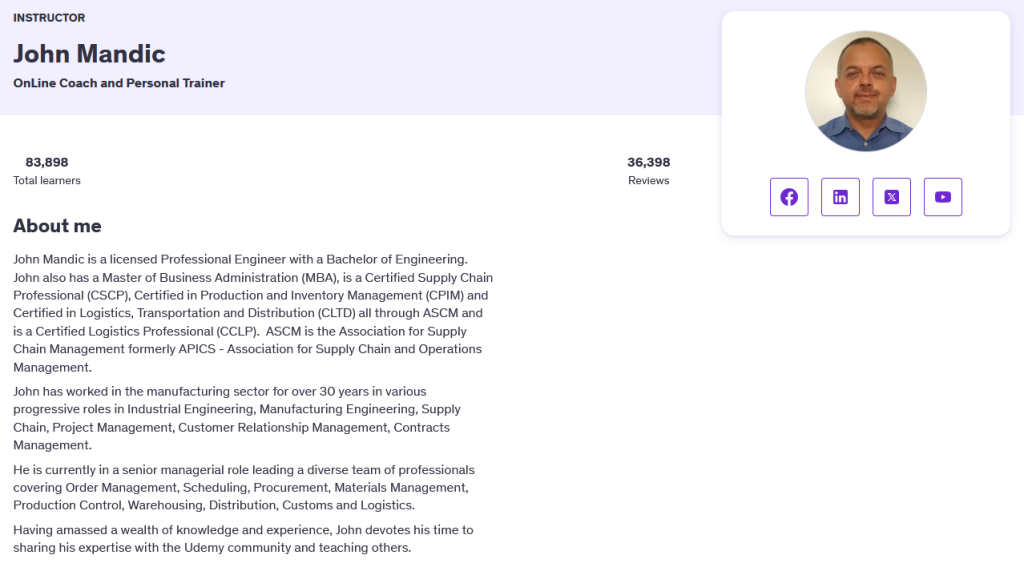If you’ve ever wondered what makes a supply chain tick—or you’re considering a career shift into logistics, manufacturing, or operations—this course might just be your new favorite starting point. Supply Chain Fundamentals: Understanding the Basics on Udemy packs a seriously detailed look at the world of supply chain management in a way that’s beginner-friendly, but also surprisingly comprehensive. From demand forecasting to inventory planning, it touches on all the moving parts (literally) that keep businesses running smoothly.
Let’s break it down.
Instructor Reputation
When it comes to choosing an online course—especially in a field as complex and essential as supply chain management—the instructor’s background can make or break your learning experience. In this case, you’re in incredibly capable hands. John Mandic brings a wealth of expertise that goes well beyond textbook knowledge. With over 30 years of industry experience, he’s not just teaching concepts—he’s teaching from real-world experience in engineering, manufacturing, and supply chain operations.

What makes John stand out is his blend of technical skill and practical leadership. He’s a licensed Professional Engineer with a Bachelor’s in Engineering and an MBA, which already gives him a strong analytical and business foundation. But it doesn’t stop there—he also holds multiple high-level certifications from the Association for Supply Chain Management (ASCM), including CPIM (Certified in Production and Inventory Management), CSCP (Certified Supply Chain Professional), and CLTD (Certified in Logistics, Transportation and Distribution). These are the gold standards for supply chain professionals, and his mastery of all three shows how deeply embedded he is in the field.
His current role in senior supply chain management sees him leading teams that handle everything from order management and procurement to warehousing and logistics. That breadth of leadership gives him the kind of holistic view that many instructors lack. On top of all this, John’s presence on Udemy is solid, with a 4.6-star instructor rating, over 83,000 students, and a track record of clear, structured teaching.
Student reviews echo these strengths. Many learners appreciate how clear and methodical his delivery is, even when he’s explaining heavy terminology. His lessons are infused with industry-relevant examples, making it easier for learners to connect abstract ideas with practical applications. In short: if you’re going to trust someone to walk you through the building blocks of supply chain management, John Mandic is about as legit as it gets.
Course Structure
The course structure for Supply Chain Fundamentals: Understanding the Basics is one of its most impressive strengths. It’s designed like a layered roadmap—guiding you from the absolute basics all the way through more advanced topics in a clear, linear way. If you’re a beginner or someone returning to the field after a break, this kind of structured flow can make a huge difference.

The course is broken down into well-organized modules, each covering a key segment of the supply chain. You start with the foundations—like understanding demand types and forecasting methods—and then move progressively through more advanced topics such as production planning, material requirements planning (MRP), and capacity planning. By the time you’re halfway through, you’ve already built a solid framework of how the entire supply chain operates from end to end.
Each section is made up of short, digestible video lessons, making it easy to learn at your own pace. There’s no unnecessary filler—each lesson adds a meaningful layer to your understanding. For example, John doesn’t just mention a concept like the Master Production Schedule (MPS)—he shows how it relates to the Production Plan, explains how to create one, and then connects it with tools like Available-to-Promise (ATP). This depth of integration is one of the course’s biggest strengths.
Another highlight is how he handles inventory management. Instead of overwhelming you with formulas and graphs, he builds your understanding step by step—explaining concepts like EOQ (Economic Order Quantity), ABC analysis, and Pareto’s Law in a way that actually makes sense, even if you’ve never touched supply chain theory before.
While the course is primarily video-based and lacks quizzes or interactive exercises, it compensates with real-world examples and a logical progression that naturally reinforces each concept. This structure is particularly helpful for learners preparing for certifications like APICS CPIM Part 1, as it covers a wide swath of exam-relevant content in a more approachable format.
Whether you’re looking to build a career in supply chain, enhance your current skill set, or just understand how supply chains really work, the course’s structure ensures that you won’t feel lost—even if you’re starting from scratch.
Content Quality
If you’re looking for a course that’s content-rich without being overwhelming, Supply Chain Fundamentals: Understanding the Basics delivers in spades. The scope of this course is incredibly impressive, especially considering it’s designed for beginners. From the first lesson, it’s clear that the content was crafted with care, aiming to build not just familiarity but real, applicable knowledge of supply chain management.

What really stands out is the depth and breadth of topics covered. You’re not just learning what supply chain is—you’re getting a structured walkthrough of each major component: demand forecasting, production planning, manufacturing strategies, material requirements planning (MRP), inventory control, and even sustainability. These aren’t surface-level mentions either. Each section provides tactical, real-world explanations that help you understand how these systems function and interact in a modern business environment.
For example, the modules on forecasting techniques and manufacturing strategies dig deep into options like qualitative versus quantitative methods and engineer-to-order versus make-to-stock models. Rather than just listing pros and cons, John shows how to choose between them, when each is useful, and what the consequences of poor alignment could be. That kind of insight is something you usually only get from hands-on experience—and it’s weaved throughout this course.
The inventory management section is another highlight. Concepts like Economic Order Quantity (EOQ), stock-outs, and carrying costs are broken down in a way that’s not just understandable but actionable. John makes it easy to connect the dots between theory and practice, especially through frameworks like ABC analysis and Pareto’s Law, which many learners find valuable for optimizing inventory efficiency.
It’s also worth noting that the course doesn’t just rely on static slides or bullet-point lists. The content is presented through spoken instruction, visual aids, and real-world analogies, which helps reinforce retention—especially if you’re a visual or auditory learner. While there aren’t quizzes or assignments to practice with, the clarity and repetition built into the structure make it easy to revisit concepts whenever needed.
Overall, the content is dense but digestible, and it offers far more than most beginner-level business courses. It’s the kind of material that not only prepares you for an entry-level job or exam but also gives you enough context to have smart, strategic conversations in a real-world business setting.
Overall Course Rating – 9/10
There’s a lot to love about Supply Chain Fundamentals: Understanding the Basics, and after completing the course, I’d confidently give it a 9 out of 10. That rating reflects not only the course’s high-quality content and structured delivery but also the experience and teaching style of instructor John Mandic, who brings decades of industry experience into every lesson.

From the start, the course positions itself as a practical gateway into the world of supply chain—and it absolutely delivers on that promise. Whether you’re prepping for APICS certification, making a career pivot into supply chain, or just wanting to round out your business acumen, this course gives you a rock-solid foundation. You can tell it’s built with intention—each topic builds on the last, every example feels grounded in real-world logic, and nothing is added just for the sake of fluff.
John’s clear explanations, paired with the logical progression from forecasting to capacity planning to inventory control, make the course highly accessible even for total newcomers. And while it would have been nice to see a few quizzes, case studies, or interactive elements, the quality of the core material more than makes up for that.
What truly sets this course apart is that it goes beyond just definitions and flowcharts—it equips you to actually understand and apply supply chain principles in a way that can improve performance and decision-making in your organization. The lack of interactivity might limit how “hands-on” the learning feels, but if you’re a self-starter who prefers to learn by listening, thinking, and reflecting, this course will work extremely well for you.
In short, this is one of the most well-rounded and thoughtfully designed introductory courses on supply chain I’ve come across on Udemy. It’s a smart investment in your professional development—especially at such an accessible price point.




